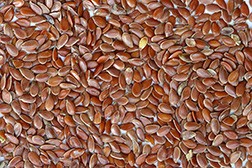Eating Green
- Share
- Tweet
- Pin
- Share
In the 8th century, King Charlemagne wrote laws requiring his citizens to eat flaxseed, believing in the health benefits of the tiny prairie crop. While Charlemagne didn’t know what lignans or omega-3s are, he may have been on to something.
Flaxseed has boasted some evidence in reducing the risk of heart disease, cancer, stroke and diabetes. This is primarily due to its three hallmark nutrients: omega-3 essential fatty acids, lignans and fiber.
Omega-3s are known as “good” fats that contribute to heart health and nervous system function. These fats are the reason salmon is also considered a health food, but flax is better on a budget. Unlike other kinds of fat, the body cannot synthesize omega-3 fats on its own, making them essential to include in the diet.
Lignans are chemical compounds found in plants that are high in antioxidants and promote estrogen activity to maintain hormone levels in men and women. Antioxidants neutralize harmful compounds in the body called free radicals, which cause damage to cell walls and are associated with cancer risk.
Fiber is a carbohydrate that the body cannot digest. In its inability to be digested, fiber curbs hunger and promotes gut health by moving waste along the digestive tract more quickly.
Flaxseed is most easily consumed in addition to everyday foods. Putting a tablespoon in oatmeal, smoothies or baking recipes will satisfy your dietary needs.
For the best nutrition punch, buy whole flaxseed and grind it yourself before storing it in the freezer.

